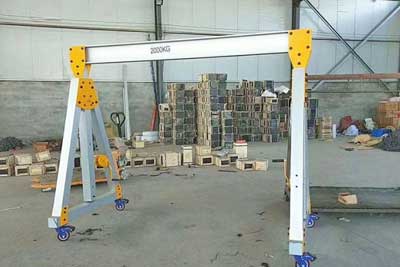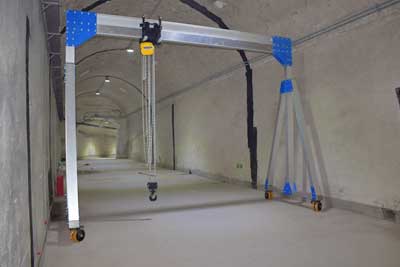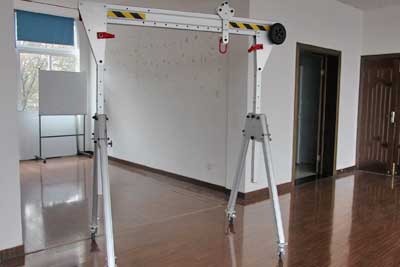Aluminum Gantry Cranes for Stage Equipment Handling
Aluminum Gantry Cranes for Stage Equipment Handling
Efficiently set up and dismantle stage lighting and sound systems with lightweight 2-ton aluminum gantry cranes in event management.
In event management, the handling of stage equipment plays a pivotal role in the success of any event. From setting up elaborate lighting rigs to ensuring seamless sound system integration, every aspect contributes to creating memorable experiences for attendees. Efficient setup and dismantling of stage equipment are critical for meeting tight event timelines, ensuring that performances, presentations, or ceremonies start and end on schedule. This section explores how lightweight aluminum gantry cranes facilitate these tasks, offering agility and reliability in maneuvering essential equipment without delays or disruptions. By enhancing the efficiency of setup and teardown processes, these cranes enable event organizers to focus more on delivering exceptional experiences and less on logistical challenges.
Basic of Lightweight Aluminum Gantry Cranes
Lightweight aluminum gantry cranes are specialized lifting devices designed for versatility and ease of use in various applications, including event management. These cranes are typically constructed from lightweight yet durable aluminum, which offers advantages such as corrosion resistance, reduced weight for easier transportation, and high strength-to-weight ratio.
Key Components and Design Features:
- Frame: The frame of a lightweight aluminum gantry crane provides structural support and stability. It is usually assembled from aluminum profiles or beams, ensuring robustness while keeping overall weight manageable. The frame design allows for easy assembly and disassembly without requiring specialized tools.
- Casters: Mounted at the base of the crane, casters facilitate mobility across different surfaces. They are often equipped with swivel and locking mechanisms to ensure smooth movement and stable positioning once the crane is in place. This mobility is crucial for navigating event venues with varying floor conditions and layouts.
- Beam: The horizontal beam spans between the vertical supports of the crane, providing the lifting mechanism with stability and load-bearing capacity. Aluminum beams are chosen for their lightweight nature, yet they can support substantial weights suitable for lifting stage equipment such as lighting trusses and sound equipment.
- Trolley: The trolley is a movable mechanism that runs along the beam, supporting the hoisting mechanism (such as an electric chain hoist or manual winch). It allows for precise positioning of loads along the length of the beam, ensuring accurate placement of stage equipment during setup and dismantling.
Lightweight aluminum gantry cranes are engineered to balance strength with portability, making them ideal for environments where quick setup and efficient operation are essential, such as event venues. Their design features emphasize ease of use, durability, and adaptability to meet the specific demands of handling stage equipment effectively.
Main Aluminum Gantry Crane Design: The Roller Travelling & Freestanding Stationery Gantry Crane with No- Rollers

Movable Aluminum Gantry Crane With Rolling Castor
- Capacity up to 5 tons.
- Span up to 4 meters.
- Max. lifting height is no more than 5 meters

Selfstanding Stationery Aluminum Gantry Crane
- Capacity up to 2 tons.
- Span up to 4 meters.
- Max. lifting height is no more than 4 meters
Variationsof Aluminum Gantry Cranes to Meet Various Industrial Needs

LT1: Aluminum Gantry Crane with Fixed Span and Height
- Capacity up to 5 tons.
- Span up to 4 meters.
- Max. height up to 5 meters
Get Fixed Span & Fixed Hight Aluminum Alloy Gantry Crane Price

lT 2 Height Adjustable Aluminum Gantry Cranes
- Capacity up to 5 tons.
- Span up to 4 meters.
- Max. height up to 5 meters

LT3: Fixed Aluminum Gantry Crane with Adjustable Span and Height
- Capacity up to 2 tons.
- Span up to 4 meters.
- Max. height up to 4 meters

lT4 Simple Gantry Cranes with adjustable Height & Span
- Capacity up to 2 tons.
- Span up to 4 meters.
- Max. height up to 4 meters

LT5:Foldable Aluminum Gantry Crane with Adjustable Span and Height
- Capacity up to 3 tons.
- Span up to 4 meters.
- Max. lifting height is no more than 6 meters

LT6 Ajustable Gantry Crane with Telescoping Height and Span T Frame Gantry Cranes
- Capacity up to 2 tons.
- Span up to 4 meters.
- Max. lifting height is no more than 4 meters
Applications in Event Management
Lightweight gantry cranes play a crucial role in various event settings, providing essential lifting solutions for handling stage equipment with efficiency and precision.
Overview of Event Settings:
In event management, lightweight gantry cranes are indispensable in venues ranging from conference centers and theaters to outdoor stages and temporary event spaces. These cranes are designed to navigate diverse environments, accommodating different floor surfaces and layouts common in event settings. Their portability and ease of setup make them versatile tools for ensuring smooth operations during event setup, execution, and teardown phases.
Specific Examples of Stage Equipment Handled:
- Lighting Systems: Lightweight gantry cranes are used to lift and position lighting trusses, spotlights, and overhead rigs. They enable technicians to adjust lighting setups quickly and precisely, enhancing visual effects and stage ambiance throughout the event.
- Sound Systems: For audio equipment, gantry cranes facilitate the lifting and installation of speakers, amplifiers, and sound mixing consoles. Their stability and mobility allow sound engineers to optimize acoustics and ensure clear, balanced audio coverage across the venue.
- Event Structures: Gantry cranes are instrumental in erecting and dismantling event structures such as stage platforms, marquees, and exhibition booths. They support the safe handling of heavy components, contributing to efficient setup timelines and ensuring event spaces are ready for use according to schedule.
In each of these applications, lightweight gantry cranes contribute to the overall success of events by streamlining logistical processes and minimizing downtime. Their ability to handle diverse stage equipment with ease makes them a valuable asset for event organizers seeking to deliver seamless and memorable experiences for attendees.
Benefits of Lightweight Aluminum Gantry Cranes
- Mobility and Maneuverability: Lightweight aluminum gantry cranes excel in event management due to their ease of transportation and setup versatility. They are designed to navigate various event venues effortlessly, from indoor conference halls to outdoor stages. Their lightweight construction and integrated casters allow for swift movement across different floor surfaces, ensuring quick deployment and repositioning as needed. This mobility capability enables event organizers to optimize space utilization and efficiently position stage equipment precisely where required for optimal event setups.
- Efficiency in Setup and Dismantling: One of the primary advantages of lightweight aluminum gantry cranes is their efficiency in setup and dismantling processes. Unlike traditional lifting methods that may require heavy machinery or extensive setup time, these cranes offer significant time-saving benefits. They can be assembled quickly without the need for specialized tools, minimizing downtime between event phases. Similarly, dismantling is equally swift, allowing event crews to efficiently clear venues and prepare for subsequent events or activities. This efficiency not only enhances overall event timelines but also reduces labor costs associated with prolonged setup periods.
- Safety and Versatility: Safety is paramount in event management, especially when handling delicate stage equipment such as lighting fixtures and audio systems. Lightweight aluminum gantry cranes are engineered with safety features that ensure stable lifting operations and protect equipment from damage. Their adjustable height and precise control mechanisms enable operators to maneuver loads with accuracy, minimizing the risk of accidents or mishaps during setup and dismantling. Moreover, these cranes are versatile, accommodating various event configurations and requirements without compromising on performance. Whether lifting heavy sound equipment or assembling intricate stage structures, their adaptability ensures consistent reliability across different event types and venues.
Case Studies and Real-World Examples
Successful Implementations of Lightweight Gantry Cranes in Event Management:
Outdoor Music Festival Setup:
- Scenario: A large-scale outdoor music festival required efficient setup of stage lighting and sound equipment across multiple performance areas.
- Solution: Lightweight aluminum gantry cranes (2-ton capacity) were deployed to transport and position lighting trusses and speaker arrays. Their mobility enabled rapid deployment across uneven terrain, ensuring timely readiness for performances.
- Outcome: Event organizers reported significant time savings in setup compared to previous years, allowing for smoother transitions between acts and enhanced attendee experiences.
Corporate Conference Installation:
- Scenario: A corporate conference in a hotel ballroom necessitated the setup of intricate stage structures and AV equipment.
- Solution: Portable aluminum gantry cranes (1.5-ton capacity) were utilized to lift and place stage platforms, LED screens, and conference room furniture. Their compact design and maneuverability facilitated precise positioning without disrupting hotel operations.
- Outcome: Event planners praised the cranes' versatility and ease of use, noting reduced setup hours and improved overall event flow, which contributed to positive attendee feedback and event success.
Testimonials from Event Planners, Technicians, or Venue Managers:
- Event Planner Testimonial: "Using lightweight gantry cranes transformed how we handle setup logistics at our events. They're quick to set up, easy to maneuver, and ensure our lighting and sound setups are flawless. They've become an indispensable part of our toolkit!"
- Technician Feedback: "The gantry cranes' mobility is a game-changer. We can position heavy equipment precisely where needed, even in tight spaces. Safety features are top-notch, which is crucial when dealing with expensive AV gear."
- Venue Manager Experience: "We've integrated these cranes into our venue's event support services. They've proven invaluable for event setup and breakdown, enhancing efficiency and minimizing disruption to our daily operations. Highly recommended!"
These case studies and testimonials underscore the practical benefits and positive impact lightweight aluminum gantry cranes have had in event management settings. Their versatility, efficiency, and safety features contribute to streamlined operations, ensuring successful events and satisfied stakeholders.
Considerations for Choosing the Right Crane
Choosing the right lightweight aluminum gantry crane for event management involves considering several key factors to ensure optimal performance and safety.
Factors Influencing Crane Selection:
Capacity:
- Event Requirements: Determine the maximum weight of stage equipment and structures that the crane needs to lift. Choose a crane with a capacity that comfortably exceeds the heaviest load to ensure safe operation.
- Versatility: Consider future needs and potential changes in equipment or event scale. Opt for a crane with adjustable capacity options if flexibility is required.
Height Adjustment:
- Venue Constraints: Assess the height limitations of event venues, including doorways, ceilings, and stage heights. Select a crane with adjustable height features to accommodate varying clearance requirements and ensure equipment can be positioned at optimal heights for performance and safety.
- Precision Handling: Adjustable height capabilities enable precise positioning of lighting rigs, sound systems, and event structures, enhancing overall event quality.
Mobility:
- Terrain and Venue Accessibility: Evaluate the terrain and accessibility of event venues. Choose a crane with robust, lockable casters suitable for navigating diverse surfaces, such as gravel, concrete, or carpeted floors.
- Maneuverability: Ensure the crane's mobility supports seamless movement within tight spaces and around obstacles commonly found in event settings. This capability facilitates efficient setup and minimizes disruption during event preparations.
Matching Crane Specifications to Event Venue and Equipment Requirements:
Event Venue Characteristics:
- Indoor vs. Outdoor: Consider whether the crane needs to operate indoors, where space may be limited, or outdoors, where it must withstand weather conditions.
- Floor Load Capacity: Verify that the crane's weight distribution and load-bearing capacity align with the venue's floor load limits to prevent damage or safety hazards.
Equipment Requirements:
- Specific Equipment Handling: Evaluate the dimensions and weight distribution of stage equipment, such as trusses, speakers, and LED screens. Ensure the crane's beam length and trolley system accommodate the size and weight of equipment to be lifted.
- Integration with Existing Systems: Coordinate crane specifications with existing event infrastructure, such as rigging points and power supply locations, to streamline setup and ensure compatibility.
By carefully considering these factors, event planners, technicians, and venue managers can select the right lightweight aluminum gantry crane that meets operational needs, enhances efficiency, and contributes to the successful execution of events.
Maintenance and Operational Tips
Maintaining lightweight gantry cranes and ensuring proper training for operators are crucial aspects of maximizing their efficiency and lifespan in event management settings.
Best Practices for Maintaining Lightweight Gantry Cranes:
Regular Inspections:
- Conduct routine visual inspections of the crane's components, including the frame, casters, beam, and trolley. Look for signs of wear, damage, or corrosion.
- Inspect mechanical and electrical parts, such as the hoist mechanism and control system, to ensure smooth operation.
Lubrication and Cleaning:
- Follow manufacturer recommendations for lubricating moving parts, such as casters and trolley wheels, to prevent friction and prolong component life.
- Keep the crane clean and free of debris, especially after outdoor use or in dusty environments, to maintain optimal performance.
Safety Checks:
- Verify the functionality of safety features, including brakes on casters and emergency stop mechanisms. Ensure these are operational to prevent accidents during crane operation.
- Test load-bearing capacities periodically to confirm the crane's ability to lift designated loads safely.
Repair and Maintenance Schedule:
- Schedule regular maintenance checks and necessary repairs with qualified technicians or crane service providers.
- Address any identified issues promptly to prevent operational disruptions and ensure the crane remains reliable for event setups.
Training Requirements for Crane Operators in Event Settings:
Technical Familiarization:
- Provide comprehensive training on the crane's operation, including setup, operation of controls, and safety procedures.
- Ensure operators understand load capacities, proper load handling techniques, and emergency protocols.
Venue-Specific Training:
- Familiarize operators with the layout and specific features of event venues where the crane will be used. Highlight any terrain challenges, restricted areas, or unique setup requirements.
- Train operators to adjust crane settings, such as height and maneuverability, to suit different venue configurations and event setups.
Safety Training:
- Emphasize safe lifting practices and the importance of situational awareness during crane operation.
- Educate operators on hazard identification and mitigation strategies, particularly in crowded or dynamic event environments.
Continued Education and Skill Development:
- Offer ongoing training opportunities to refresh skills, update knowledge on new crane technologies, and reinforce safety protocols.
- Encourage operators to participate in certification programs or industry workshops to enhance their proficiency and professionalism in crane operations.
By implementing these maintenance and training practices, event organizers can ensure that lightweight gantry cranes operate reliably, maintain safety standards, and contribute to efficient event management operations.
Conclusion
In conclusion, lightweight aluminum gantry cranes emerge as indispensable tools in event management, offering numerous advantages that enhance efficiency and safety throughout event setups and operations. These cranes facilitate swift transportation, precise positioning, and efficient handling of stage equipment such as lighting rigs, sound systems, and event structures. Their mobility and maneuverability enable seamless navigation across diverse event venues, whether indoor conference spaces or outdoor festival grounds.
Integrating lightweight gantry cranes into event logistics not only streamlines setup and dismantling processes but also contributes to minimizing downtime and optimizing event timelines. By choosing cranes with adjustable capacities and height settings, event organizers can tailor lifting solutions to meet specific venue and equipment requirements effectively. This flexibility ensures that event setups are executed with precision and reliability, ultimately enhancing attendee experiences and event success.
As event management continues to evolve, the role of efficient lifting solutions like lightweight gantry cranes becomes increasingly pivotal. Their ability to support safe and efficient operations underscores their importance in delivering seamless events that leave lasting impressions. By prioritizing the integration of these advanced lifting technologies, event planners and managers can elevate the quality of their productions while ensuring operational excellence and customer satisfaction.




